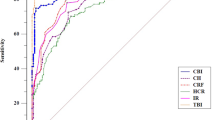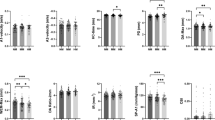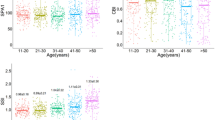Abstract
Objectives
We studied the difference in the corneal biomechanical parameters of ptotic and fellow eyes in patients with congenital blepharoptosis. The correlations between corneal biomechanical parameters and demographic or ocular parameters, and the changes after surgery were also researched.
Methods
The corneal biomechanical parameters were measured by Corvis ST tonometry. The central corneal thickness (CCT), axial length (AL) and keratometry measurements were performed with LenStar LS900, and intraocular pressure (IOP) by non-contact applanation tonometry. The parameters were evaluated for the effect of ptosis and the relationship of corneal biomechanical parameters. These examinations were repeated 6 months after blepharoptosis surgery.
Results
Twenty-nine patients were enroled. The Corvis ST parameters (Deformation amplitude [DA], A1 times, and A1 velocity), CCT, IOP with NCT, IOP with corrected, differed significantly between ptotic and fellow eyes. CCT was significantly positively correlated with Length A1 and IOP with Corvis, and negatively correlated with IOP corrected by Corvis of the ptotic eyes. The same tendency was found in the fellow eyes. Six months after the ptosis surgery, the differences in corneal biomechanics parameters between ptotic eyes and fellow eyes were not significantly changed.
Conclusions
Congenital blepharoptosis causes significant corneal biomechanical changes measured by Corvis ST. The ptotic eyes had thicker and less deformable corneas. The differences in corneal biomechanics between ptotic eyes and fellow eyes were mostly related to CCT changes. Six months after surgery, these differences in corneal biomechanics did not change significantly.
Similar content being viewed by others
Login or create a free account to read this content
Gain free access to this article, as well as selected content from this journal and more on nature.com
or
References
SooHoo JR, Davies BW, Allard FD, Durairaj VD. Congenital ptosis. Surv Ophthalmol. 2014;59:483–92.
Srinagesh V, Simon JW, Meyer DR, Zobal-Ratner J. The association of refractive error, strabismus, and amblyopia with congenital ptosis. J AAPOS. 2011;15:541–4.
Oral Y, Ozgur OR, Akcay L, Ozbas M, Dogan OK. Congenital ptosis and amblyopia. J Pediatr Ophthalmol Strabismus. 2010;47:101–4.
Skaat A, Fabian D, Spierer A, Rosen N, Rosner M, Ben SG. Congenital ptosis repair-surgical, cosmetic, and functional outcome: a report of 162 cases. Can J Ophthalmol. 2013;48:93–98.
Zhu T, Ye X, Xu P, et al. Changes of corneal tomography in patients with congenital blepharoptosis. Sci Rep. 2017;7:6580.
Paik J, Kim S, Park SH, Yang S. Refractive error characteristics in patients with congenital blepharoptosis before and after ptosis repair surgery. BMC Ophthalmol. 2016;16:177–83.
Trivizki O, Shahar J, Levinger S, Levinger E. Air-pulse corneal applanation signal curve parameters for characterization of astigmatic corneas. Cornea. 2014;33:721–5.
Griepentrog GJ, Diehl NN, Mohney BG. Incidence and demographics of childhood ptosis. Ophthalmology. 2011;118:1180–3.
Gursoy H, Sahin A, Basmak H, Ozer A, Yildirim N, Colak E. Lenstar versus ultrasound for ocular biometry in a pediatric population. Optom Vis Sci. 2011;88:912–9.
O’Donnell C, Hartwig A, Radhakrishnan H. Comparison of central corneal thickness and anterior chamber depth measured using LenStar LS900, Pentacam, and Visante AS-OCT. Cornea. 2012;31:983–8.
Wu N, Chen Y, Yu X, Li M, Wen W, Sun X. Changes in corneal biomechanical properties after long-term topical prostaglandin therapy. PLOS ONE. 2016;11:e155527.
Glass DH, Roberts CJ, Litsky AS, Weber PA. A viscoelastic biomechanical model of the cornea describing the effect of viscosity and elasticity on hysteresis. Investig Ophthalmol Vis Sci. 2008;49:3919–26.
Touboul D, Roberts C, Kerautret J, et al. Correlations between corneal hysteresis, intraocular pressure, and corneal central pachymetry. J Cataract Refract Surg. 2008;34:616–22.
Chua J, Nongpiur ME, Zhao W, et al. Comparison of corneal biomechanical properties between Indian and Chinese adults. Ophthalmology. 2017;124:1271–9.
Matsuura M, Hirasawa K, Murata H, et al. The relationship between Corvis ST tonometry and ocular response analyzer measurements in eyes with glaucoma. PLOS ONE. 2016;11:e161742.
von Noorden GK, Lewis RA. Ocular axial length in unilateral congenital cataracts and blepharoptosis. Investig Ophthalmol Vis Sci. 1987;28:750–2.
Robert L, Legeais JM, Robert AM, Renard G. Corneal collagens. Pathol Biol. 2001;49:353–63.
He M, Ding H, He H, Zhang C, Liu L, Zhong X. Corneal biomechanical properties in healthy children measured by corneal visualization scheimpflug technology. BMC Ophthalmol. 2017;17:70–6.
Kotecha A. What biomechanical properties of the cornea are relevant for the clinician? Surv Ophthalmol. 2007;52 Suppl:S109–S114.
Schweitzer C, Korobelnik JF, Boniol M, et al. Associations of biomechanical properties of the cornea with environmental and metabolic factors in an elderly population: the ALIENOR Study. Investig Ophthalmol Vis Sci. 2016;57:2003–11.
Ardan T, Nemcova L, Bohuslavova B, et al. Reduced levels of tissue inhibitors of metalloproteinases in UVB-irradiated corneal epithelium. Photochem Photobiol. 2016;92:720–7.
Daxer A, Misof K, Grabner B, Ettl A, Fratzl P. Collagen fibrils in the human corneal stroma: structure and aging. Investig Ophthalmol Vis Sci. 1998;39:644–8.
Salvetat ML, Zeppieri M, Tosoni C, Felletti M, Grasso L, Brusini P. Corneal deformation parameters provided by the corvis-ST pachy-tonometer in healthy subjects and glaucoma patients. J Glaucoma. 2015;24:568–74.
Lanza M, Cennamo M, Iaccarino S, et al. Evaluation of corneal deformation analyzed with Scheimpflug based device in healthy eyes and diseased ones. Biomed Res Int. 2014;2014:748671.
Valbon BF, Ambrosio RJ, Fontes BM, Luz A, Roberts CJ, Alves MR. Ocular biomechanical metrics by CorVis ST in healthy Brazilian patients. J Refract Surg. 2014;30:468–73.
Savino G, Battendieri R, Riso M, et al. Corneal topographic changes after eyelid ptosis surgery. Cornea. 2016;35:501–5.
Cadera W, Orton RB, Hakim O. Changes in astigmatism after surgery for congenital ptosis. J Pediatr Ophthalmol Strabismus. 1992;29:85–88.
Chisholm S, Costakos DM, Harris GJ. Surgical timing for congenital ptosis should not be determined solely by the presence of anisometropia. Ophthalmic Plast Reconstr Surg. 2019;35:374–7.
Funding
This work is supported by grants from the Special Fund Project of Science and Technology in Guangdong Province (2018YJ036), and the Research and Development and Upgrading Fund of Enterprises in Guangdong Province (2013B022200002).
Author information
Authors and Affiliations
Corresponding author
Ethics declarations
Conflict of interest
The authors declare that they have no conflict of interest.
Additional information
Publisher’s note Springer Nature remains neutral with regard to jurisdictional claims in published maps and institutional affiliations.
Rights and permissions
About this article
Cite this article
Li, X., Liu, C., Mao, Z. et al. Effect of congenital blepharoptosis on corneal biomechanical properties and changes after ptosis surgery. Eye 34, 1055–1062 (2020). https://doi.org/10.1038/s41433-019-0586-9
Received:
Revised:
Accepted:
Published:
Issue Date:
DOI: https://doi.org/10.1038/s41433-019-0586-9
This article is cited by
-
How ptosis affects the visual quality: an overview of visual quality impairments and contributing factors in ptotic eyes
International Ophthalmology (2025)
-
Corneal biophysical changes after upper eyelid blepharoplasty and ptosis surgery: a review
BMC Ophthalmology (2023)
-
Influence of Upper Eyelid Surgeries on Corneal Morphology Detected with Pentacam
Aesthetic Plastic Surgery (2023)
-
Refractive error characteristics and influence on ocular parameters in patients with unilateral congenital ptosis
BMC Ophthalmology (2022)
-
Clinical observations of corneal topographic and tomographic changes in congenital ptosis eyes: a study in China
International Ophthalmology (2022)



